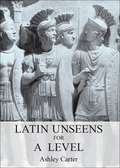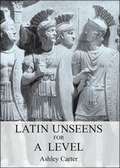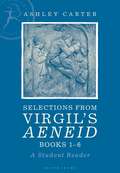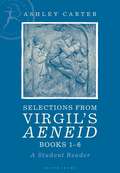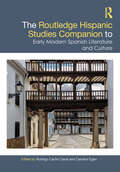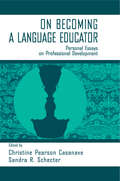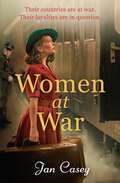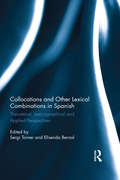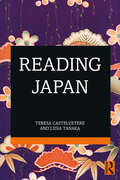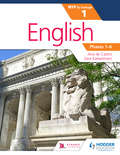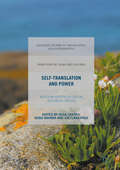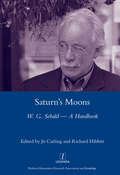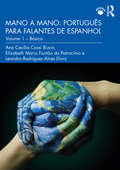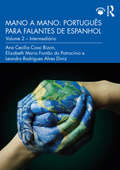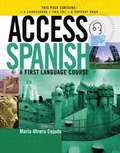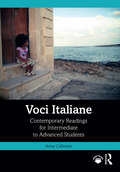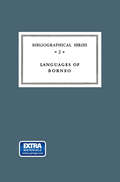- Table View
- List View
Latin Unseens for A Level
by Ashley CarterThis collection of Latin unseen passages forms a companion volume to Latin Momentum Tests for GCSE, and is intended to be used similarly by students preparing for examinations at AS, A2 and AEA levels. The largest section is set at AS level and comprises prose passages forming a coherent story based on original sources but simplified to maintain a level of difficulty appropriate for this level. The text assumes the student will have a working knowledge of a typical vocabulary list of about 1000 words. Most of the rest of the passages are, with rare exceptions, un-adapted Latin, both prose and verse, taken from the authors used in the examinations. Difficult or rare words are glossed. The last few passages are of a standard of difficulty appropriate to AEA level. All passages are of a similar length and format to those used in the examinations. One sample mark scheme has been included to give teachers and students some insight into how these unseens are marked in the examinations.
Latin Unseens for A Level
by Ashley CarterThis collection of Latin unseen passages forms a companion volume to Latin Momentum Tests for GCSE, and is intended to be used similarly by students preparing for examinations at AS, A2 and AEA levels. The largest section is set at AS level and comprises prose passages forming a coherent story based on original sources but simplified to maintain a level of difficulty appropriate for this level. The text assumes the student will have a working knowledge of a typical vocabulary list of about 1000 words. Most of the rest of the passages are, with rare exceptions, un-adapted Latin, both prose and verse, taken from the authors used in the examinations. Difficult or rare words are glossed. The last few passages are of a standard of difficulty appropriate to AEA level. All passages are of a similar length and format to those used in the examinations. One sample mark scheme has been included to give teachers and students some insight into how these unseens are marked in the examinations.
Latin Unseens For A Level (PDF)
by Ashley CarterThis collection of Latin unseen passages forms a companion volume to Latin Momentum Tests for GCSE, and is intended to be used similarly by students preparing for examinations at AS, A2 and AEA levels. The largest section is set at AS level and comprises prose passages forming a coherent story based on original sources but simplified to maintain a level of difficulty appropriate for this level. A knowledge of a typical vocabulary list of about 1000 words is assumed. Most of the rest of the passages are, with rare exceptions, unadapted Latin, both prose and verse, taken from the authors used in the examinations. Difficult or rare words are glossed. The last few passages are of a standard of difficulty appropriate to AEA level. All passages are of a similar length and format to those used in the examinations. One sample mark scheme has been included to give teachers and students some insight into how these unseens are marked in the examinations.
Selections from Virgil's Aeneid Books 1-6: A Student Reader
by Ashley CarterThis reader of Virgil's text features passages from the first half of the Aeneid and is designed to help students understand and appreciate Virgil's poem, as well as improve their Latin reading skills. Each Latin passage is accompanied by running vocabulary, on-page commentary notes and targeted questions. The book can be used as a source of one-off unseen passages or as a reader for students working through individual books or the whole poem. The commentary notes explain references to characters, places and events, provide linguistic and grammatical help on more challenging Latin phrases, and point out stylistic features. The questions test students' comprehension of the characters and storyline, and give them practice in handling literary terms. The passages are linked by summaries of the continuing plot, so students can grasp the progression of the poem as a whole. An in-depth introduction sets the story of the Aeneid in its mythological, literary and historical contexts; a glossary of literary devices and sections on style and metre are included. At the end of the book is a complete alphabetical vocabulary list.
Selections from Virgil's Aeneid Books 1-6: A Student Reader
by Ashley CarterThis reader of Virgil's text features passages from the first half of the Aeneid and is designed to help students understand and appreciate Virgil's poem, as well as improve their Latin reading skills. Each Latin passage is accompanied by running vocabulary, on-page commentary notes and targeted questions. The book can be used as a source of one-off unseen passages or as a reader for students working through individual books or the whole poem. The commentary notes explain references to characters, places and events, provide linguistic and grammatical help on more challenging Latin phrases, and point out stylistic features. The questions test students' comprehension of the characters and storyline, and give them practice in handling literary terms. The passages are linked by summaries of the continuing plot, so students can grasp the progression of the poem as a whole. An in-depth introduction sets the story of the Aeneid in its mythological, literary and historical contexts; a glossary of literary devices and sections on style and metre are included. At the end of the book is a complete alphabetical vocabulary list.
The Routledge Hispanic Studies Companion to Early Modern Spanish Literature and Culture (Routledge Companions to Hispanic and Latin American Studies)
by Rodrigo Cacho Casal Caroline EganThe Routledge Hispanic Studies Companion to Early Modern Spanish Literature and Culture introduces the intellectual and artistic breadth of early modern Spain from a range of disciplinary and critical perspectives. Spanning the sixteenth and seventeenth centuries (a period traditionally known as the Golden Age), the volume examines topics including political and scientific culture, literary and artistic innovations, and religious and social identities and institutions in transformation. The 36 chapters of the volume include both expert overviews of key topics and figures from the period as well as new approaches to understudied questions and materials. This invaluable resource will be of interest to advanced students and scholars in Hispanic studies, as well as Renaissance and early modern studies more generally.
The Routledge Hispanic Studies Companion to Early Modern Spanish Literature and Culture (Routledge Companions to Hispanic and Latin American Studies)
by Rodrigo Cacho Casal Caroline Egan Javier Muñoz-BasolsThe Routledge Hispanic Studies Companion to Early Modern Spanish Literature and Culture introduces the intellectual and artistic breadth of early modern Spain from a range of disciplinary and critical perspectives. Spanning the sixteenth and seventeenth centuries (a period traditionally known as the Golden Age), the volume examines topics including political and scientific culture, literary and artistic innovations, and religious and social identities and institutions in transformation. The 36 chapters of the volume include both expert overviews of key topics and figures from the period as well as new approaches to understudied questions and materials. This invaluable resource will be of interest to advanced students and scholars in Hispanic studies, as well as Renaissance and early modern studies more generally.
on Becoming A Language Educator: Personal Essays on Professional Development
by Christine Pears Casanave Sandra R. SchecterThese personal essays by first and second language researchers and practitioners reflect on issues, events, and people in their lives that helped them carve out their career paths or clarify an important dimension of their missions as educators. Their narratives depict the ways in which professionals from diverse backgrounds and work settings have grappled with issues in language education that concern all of us: the sources and development of beliefs about language and education, the constructing of a professional identity in the face of ethical and ideological dilemmas, and the constraints and inspirations of teaching and learning environments. They have come together as a collective to engage in a courageous new form of academic discourse, one with the potential to change the field. Many of the authors write their stories of having begun their work with voices positioned at the margins. Now, as established professionals, they feel strong enough collectively to risk the telling and, through their telling, to encourage other voices. This volume is intended to provide graduate students, teachers, and researchers in language education with insights into the struggles that characterize the professional development of language educators. Both readers and contributors should use the stories to view their own professional lives from fresh perspectives -- and be inspired to reflect in new ways on the ideological, ethical, and philosophical underpinnings of their professional personae.
on Becoming A Language Educator: Personal Essays on Professional Development
by Christine Pearson Casanave Sandra R. SchecterThese personal essays by first and second language researchers and practitioners reflect on issues, events, and people in their lives that helped them carve out their career paths or clarify an important dimension of their missions as educators. Their narratives depict the ways in which professionals from diverse backgrounds and work settings have grappled with issues in language education that concern all of us: the sources and development of beliefs about language and education, the constructing of a professional identity in the face of ethical and ideological dilemmas, and the constraints and inspirations of teaching and learning environments. They have come together as a collective to engage in a courageous new form of academic discourse, one with the potential to change the field. Many of the authors write their stories of having begun their work with voices positioned at the margins. Now, as established professionals, they feel strong enough collectively to risk the telling and, through their telling, to encourage other voices. This volume is intended to provide graduate students, teachers, and researchers in language education with insights into the struggles that characterize the professional development of language educators. Both readers and contributors should use the stories to view their own professional lives from fresh perspectives -- and be inspired to reflect in new ways on the ideological, ethical, and philosophical underpinnings of their professional personae.
Women at War
by Jan CaseyTwo women. One war. For Viola Baxter, 1939 was supposed to be a wonderful year. After meeting and falling in love with dashing Fred Scholz at Cambridge University, they planned to marry and start their new lives together. She never imagined her father would say no to the marriage. Fred is half-German and, with war fast approaching, he must travel to Germany to bring his sister home. But that journey is enough for others to suspect him... and Viola.When Annie Scholz heard her beloved grandmother was seriously ill, she wasted no time rushing to Germany to be by her side. She didn't realise it meant she would not be able to return home to the UK, or that her decision would endanger her brother, Fred, as well. Even reuniting with her childhood beau is bittersweet – how can she love someone who stands for everything she opposes? With everyone watching Annie and Fred so closely, there is no room for error... or dangerous resistance.With war the only certainty, there's just one thing in question: where do Viola and Annie's loyalties lie? Women at War is the thrilling and heart-wrenching new WW2 story from Jan Casey, author of The Women of Waterloo Bridge. What readers are saying about Women at War: '[A] captivating, heart wrenching saga... I adamantly recommend' - 5* reader review'A story of courage and hope' - 5* reader review'I love this book... This book drew me in straight away and I just wanted to keep on reading until I finished it. A lovely story' - 5* reader review'Poignant, warm, gut wrenching and hopeful, this book is just beautiful. I stayed riveted the entire time and could not put it down' - 5* reader review'The book is full of fervor and the characters grow from beginning to end! I could not put the book down!' - 5* reader review
Collocations and other lexical combinations in Spanish: Theoretical, lexicographical and applied perspectives
by Sergi Torner Castells Elisenda Bernal GallenThis edited collection presents the state of the art in research related to lexical combinations and their restrictions in Spanish from a variety of theoretical approaches, ranging from Explanatory Combinatorial Lexicology to Distributed Morphology and Generative Lexicon Theory. Section 1 offers a presentation of the main theoretical and descriptive approaches to collocation. Section 2 explores collocation from the point of view of its lexicographical representation, while Section 3 offers a pedagogical perspective. Section 4 surveys current research on collocation in Catalan, Galician and Basque. Collocations and other lexical combinations in Spanish will be of interest to students of Hispanic linguistics.
Collocations and other lexical combinations in Spanish: Theoretical, lexicographical and applied perspectives
by Sergi Torner Castells Elisenda Bernal GallenThis edited collection presents the state of the art in research related to lexical combinations and their restrictions in Spanish from a variety of theoretical approaches, ranging from Explanatory Combinatorial Lexicology to Distributed Morphology and Generative Lexicon Theory. Section 1 offers a presentation of the main theoretical and descriptive approaches to collocation. Section 2 explores collocation from the point of view of its lexicographical representation, while Section 3 offers a pedagogical perspective. Section 4 surveys current research on collocation in Catalan, Galician and Basque. Collocations and other lexical combinations in Spanish will be of interest to students of Hispanic linguistics.
Reading Japan
by Teresa Castelvetere Lidia TanakaReading Japan offers the student readings on geopolitics, education, language, Japanese-ness and ethnicity, gender and history, with the dual aims of broadening students’ understanding of Japan and of providing opportunities to read authentic Japanese texts. Each chapter contains an essay in English, a selection of readings in Japanese, comprehensive vocabulary lists, discussion questions and a list of sources and additional readings. Pitched at Intermediate to Advanced and B1-C1 level, this reader is not simply a language textbook; it offers students a chance to learn and think in depth about Japan as they build confidence in reading real-world Japanese texts.
English for the IB MYP 1
by Ana De Castro Zara KaiserimamA concept-driven and assessment-focused approach to English language acquisition teaching and learning. - Approaches each chapter with statements of inquiry framed by key and related concepts, set in a global context- Supports every aspect of assessment using tasks designed by an experienced MYP educator- Differentiates and extends learning with research projects and interdisciplinary opportunities- Applies global contexts in meaningful ways to offer an MYP English programme with an internationally-minded perspective
Self-Translation and Power: Negotiating Identities in European Multilingual Contexts (Palgrave Studies in Translating and Interpreting)
by Olga Castro Sergi Mainer Svetlana PageThis book investigates the political, social, cultural and economic implications of self-translation in multilingual spaces in Europe. Engaging with the ‘power turn’ in translation studies contexts, it offers innovative perspectives on the role of self-translators as cultural and ideological mediators. The authors explore the unequal power relations and centre-periphery dichotomies of Europe’s minorised languages, literatures and cultures. They recognise that the self-translator’s double affiliation as author and translator places them in a privileged position to challenge power, to negotiate the experiences of the subaltern and colonised, and to scrutinise conflicting minorised vs. hegemonic cultural identities. Three main themes are explored in relation to self-translation: hegemony and resistance; self-minorisation and self-censorship; and collaboration, hybridisation and invisibility. This edited collection will appeal to scholars and students working on translation, transnational and postcolonial studies, and multilingual and multicultural identities.
Saturn's Moons: A W.G Sebald Handbook
by Jo CatlingThe German novelist, poet and critic W. G. Sebald (1944-2001) has in recent years attracted a phenomenal international following for his evocative prose works such as Die Ausgewanderten (The Emigrants), Die Ringe des Saturn (The Rings of Saturn) and Austerlitz, spellbinding elegiac narratives which, through their deliberate blurring of genre boundaries and provocative use of photography, explore questions of Heimat and exile, memory and loss, history and natural history, art and nature. Saturn's Moons: a W. G. Sebald Handbook brings together in one volume a wealth of new critical and visual material on Sebald's life and works, covering the many facets and phases of his literary and academic careers -- as teacher, as scholar and critic, as colleague and as collaborator on translation. Lavishly illustrated, the Handbook also contains a number of rediscovered short pieces by W. G. Sebald, hitherto unpublished interviews, a catalogue of his library, and selected poems and tributes, as well as extensive primary and secondary bibliographies, details of audiovisual material and interviews, and a chronology of life and works. Drawing on a range of original sources from Sebald's Nachlass - the most important part of which is now held in the Deutsches Literaturarchiv Marbach - Saturn's Moons6g will be an invaluable sourcebook for future Sebald studies in English and German alike, complementing and augmenting recent critical works on subjects such as history, memory, modernity, reader response and the visual. The contributors include Mark Anderson, Anthea Bell, Ulrich von Buelow, Jo Catling, Michael Hulse, Florian Radvan, Uwe Schuette, Clive Scott, Richard Sheppard, Gordon Turner, Stephen Watts and Luke Williams. Jo Catling teaches in the School of Literature at the University of East Anglia and Richard Hibbitt in the Department of French at the University of Leeds.
Saturn's Moons: A W.G Sebald Handbook
by Jo CatlingThe German novelist, poet and critic W. G. Sebald (1944-2001) has in recent years attracted a phenomenal international following for his evocative prose works such as Die Ausgewanderten (The Emigrants), Die Ringe des Saturn (The Rings of Saturn) and Austerlitz, spellbinding elegiac narratives which, through their deliberate blurring of genre boundaries and provocative use of photography, explore questions of Heimat and exile, memory and loss, history and natural history, art and nature. Saturn's Moons: a W. G. Sebald Handbook brings together in one volume a wealth of new critical and visual material on Sebald's life and works, covering the many facets and phases of his literary and academic careers -- as teacher, as scholar and critic, as colleague and as collaborator on translation. Lavishly illustrated, the Handbook also contains a number of rediscovered short pieces by W. G. Sebald, hitherto unpublished interviews, a catalogue of his library, and selected poems and tributes, as well as extensive primary and secondary bibliographies, details of audiovisual material and interviews, and a chronology of life and works. Drawing on a range of original sources from Sebald's Nachlass - the most important part of which is now held in the Deutsches Literaturarchiv Marbach - Saturn's Moons6g will be an invaluable sourcebook for future Sebald studies in English and German alike, complementing and augmenting recent critical works on subjects such as history, memory, modernity, reader response and the visual. The contributors include Mark Anderson, Anthea Bell, Ulrich von Buelow, Jo Catling, Michael Hulse, Florian Radvan, Uwe Schuette, Clive Scott, Richard Sheppard, Gordon Turner, Stephen Watts and Luke Williams. Jo Catling teaches in the School of Literature at the University of East Anglia and Richard Hibbitt in the Department of French at the University of Leeds.
Mano a Mano: Volume 1 – Básico (Mano a mano: português para falantes de espanhol)
by Ana Cecília Cossi Bizon Elizabeth Maria Fontão do Patrocínio Leandro Rodrigues Alves DinizMano a Mano: Português para Falantes de Espanhol vem preencher uma importante lacuna no mercado editorial: a carência de livros didáticos que, considerando as necessidades específicas de falantes de espanhol, favoreçam um desenvolvimento mais rápido de sua proficiência em português. A coleção reúne uma série de características favoráveis à aprendizagem do português em diferentes contextos (ensino médio, universidades, cursos livres): Convida o(a) aluno(a) a desenvolver sua proficiência em português ao mesmo tempo que forma uma imagem multifacetada do Brasil, em diálogo com suas próprias construções culturais, desconstruindo discursos estabilizados e ampliando seus horizontes; Favorece o trânsito por múltiplas práticas de letramento, em que circulam diferentes gêneros discursivos, oferecendo oportunidades para que o(a) estudante aprimore suas capacidades de linguagem em contextos reais, ou próximos a situações autênticas de interação; Sensibiliza o(a) aluno(a) para diferentes variedades da língua portuguesa; Permite ao(à) estudante desenvolver suas capacidades léxico-gramaticais e fonético-fonológicas de maneira reflexiva e contextualizada, levando em consideração necessidades específicas de falantes de espanhol; Propõe tarefas semelhantes às encontradas no Certificado de Proficiência em Língua Portuguesa para Estrangeiros (Celpe-Bras), do Ministério da Educação brasileiro; É acompanhado por dois cadernos complementares integrados, com explicações detalhadas referentes a recursos léxico-gramaticais e fonético-fonológicos, além de uma série de atividades; Disponibiliza online os vídeos e áudios de tarefas de compreensão oral e de atividades de pronúncia. Preparado para o desenvolvimento de um curso de até 60 horas em contexto de imersão, ou 90 horas de não-imersão, Mano a Mano, Volume 1 – Básico permite levar falantes de espanhol (como língua materna ou estrangeira/adicional) que nunca tiveram contato significativo prévio com o português até o início do nível Intermediário do Celpe-Bras, do B1 do Quadro Europeu Comum de Referência para as Línguas, ou do Intermediário Médio do American Council on the Teaching of Foreign Languages.
Mano a Mano: Volume 1 – Básico (Mano a mano: português para falantes de espanhol)
by Ana Cecília Cossi Bizon Elizabeth Maria Fontão do Patrocínio Leandro Rodrigues Alves DinizMano a Mano: Português para Falantes de Espanhol vem preencher uma importante lacuna no mercado editorial: a carência de livros didáticos que, considerando as necessidades específicas de falantes de espanhol, favoreçam um desenvolvimento mais rápido de sua proficiência em português. A coleção reúne uma série de características favoráveis à aprendizagem do português em diferentes contextos (ensino médio, universidades, cursos livres): Convida o(a) aluno(a) a desenvolver sua proficiência em português ao mesmo tempo que forma uma imagem multifacetada do Brasil, em diálogo com suas próprias construções culturais, desconstruindo discursos estabilizados e ampliando seus horizontes; Favorece o trânsito por múltiplas práticas de letramento, em que circulam diferentes gêneros discursivos, oferecendo oportunidades para que o(a) estudante aprimore suas capacidades de linguagem em contextos reais, ou próximos a situações autênticas de interação; Sensibiliza o(a) aluno(a) para diferentes variedades da língua portuguesa; Permite ao(à) estudante desenvolver suas capacidades léxico-gramaticais e fonético-fonológicas de maneira reflexiva e contextualizada, levando em consideração necessidades específicas de falantes de espanhol; Propõe tarefas semelhantes às encontradas no Certificado de Proficiência em Língua Portuguesa para Estrangeiros (Celpe-Bras), do Ministério da Educação brasileiro; É acompanhado por dois cadernos complementares integrados, com explicações detalhadas referentes a recursos léxico-gramaticais e fonético-fonológicos, além de uma série de atividades; Disponibiliza online os vídeos e áudios de tarefas de compreensão oral e de atividades de pronúncia. Preparado para o desenvolvimento de um curso de até 60 horas em contexto de imersão, ou 90 horas de não-imersão, Mano a Mano, Volume 1 – Básico permite levar falantes de espanhol (como língua materna ou estrangeira/adicional) que nunca tiveram contato significativo prévio com o português até o início do nível Intermediário do Celpe-Bras, do B1 do Quadro Europeu Comum de Referência para as Línguas, ou do Intermediário Médio do American Council on the Teaching of Foreign Languages.
Mano a Mano: Volume 2 – Intermediário (Mano a mano: português para falantes de espanhol)
by Ana Cecília Cossi Bizon Elizabeth Maria Fontão do Patrocínio Leandro Rodrigues Alves DinizMano a Mano: Português para Falantes de Espanhol vem preencher uma importante lacuna no mercado editorial: a carência de livros didáticos que, considerando as necessidades específicas de falantes de espanhol, favoreçam um desenvolvimento mais rápido de sua proficiência em português. A coleção reúne uma série de características favoráveis à aprendizagem do português em diferentes contextos (ensino médio, universidades, cursos livres): Convida o(a) aluno(a) a desenvolver sua proficiência em português ao mesmo tempo em que forma uma imagem multifacetada do Brasil, em diálogo com suas próprias construções culturais, desconstruindo discursos estabilizados e ampliando seus horizontes; Favorece o trânsito por múltiplas práticas de letramento, em que circulam diferentes gêneros discursivos, oferecendo oportunidades para que o(a) estudante aprimore suas capacidades de linguagem em contextos reais, ou próximos a situações autênticas de interação; Sensibiliza o(a) aluno(a) para diferentes variedades da língua portuguesa; Permite ao(à) estudante desenvolver suas capacidades léxico-gramaticais e fonético-fonológicas de maneira reflexiva e contextualizada, levando em consideração necessidades específicas de falantes de espanhol; Propõe tarefas semelhantes às encontradas no Certificado de Proficiência em Língua Portuguesa para Estrangeiros (Celpe-Bras), do Ministério da Educação brasileiro; É acompanhado por dois cadernos complementares integrados, com explicações detalhadas referentes a recursos léxico-gramaticais e fonético-fonológicos, além de uma série de atividades; Disponibiliza online os vídeos e áudios de tarefas de compreensão oral e de atividades de pronúncia. Preparado para o desenvolvimento de um curso de até 60 horas em contexto de imersão, ou 90 horas em contexto de não-imersão, Mano a Mano, Volume 2 – Intermediário permite levar falantes de espanhol (como língua materna ou estrangeira/adicional) do início do Intermediário Superior do Celpe-Bras, do início do B1 ao início do B2 do Quadro Europeu Comum de Referência para as Línguas, ou do início do Intermediário Médio ao início do Avançado Médio na escala do American Council on the Teaching of Foreign Languages.
Mano a Mano: Volume 2 – Intermediário (Mano a mano: português para falantes de espanhol)
by Ana Cecília Cossi Bizon Elizabeth Maria Fontão do Patrocínio Leandro Rodrigues Alves DinizMano a Mano: Português para Falantes de Espanhol vem preencher uma importante lacuna no mercado editorial: a carência de livros didáticos que, considerando as necessidades específicas de falantes de espanhol, favoreçam um desenvolvimento mais rápido de sua proficiência em português. A coleção reúne uma série de características favoráveis à aprendizagem do português em diferentes contextos (ensino médio, universidades, cursos livres): Convida o(a) aluno(a) a desenvolver sua proficiência em português ao mesmo tempo em que forma uma imagem multifacetada do Brasil, em diálogo com suas próprias construções culturais, desconstruindo discursos estabilizados e ampliando seus horizontes; Favorece o trânsito por múltiplas práticas de letramento, em que circulam diferentes gêneros discursivos, oferecendo oportunidades para que o(a) estudante aprimore suas capacidades de linguagem em contextos reais, ou próximos a situações autênticas de interação; Sensibiliza o(a) aluno(a) para diferentes variedades da língua portuguesa; Permite ao(à) estudante desenvolver suas capacidades léxico-gramaticais e fonético-fonológicas de maneira reflexiva e contextualizada, levando em consideração necessidades específicas de falantes de espanhol; Propõe tarefas semelhantes às encontradas no Certificado de Proficiência em Língua Portuguesa para Estrangeiros (Celpe-Bras), do Ministério da Educação brasileiro; É acompanhado por dois cadernos complementares integrados, com explicações detalhadas referentes a recursos léxico-gramaticais e fonético-fonológicos, além de uma série de atividades; Disponibiliza online os vídeos e áudios de tarefas de compreensão oral e de atividades de pronúncia. Preparado para o desenvolvimento de um curso de até 60 horas em contexto de imersão, ou 90 horas em contexto de não-imersão, Mano a Mano, Volume 2 – Intermediário permite levar falantes de espanhol (como língua materna ou estrangeira/adicional) do início do Intermediário Superior do Celpe-Bras, do início do B1 ao início do B2 do Quadro Europeu Comum de Referência para as Línguas, ou do início do Intermediário Médio ao início do Avançado Médio na escala do American Council on the Teaching of Foreign Languages.
Access Spanish - A First Language Course (PDF)
by Maria Utrera Cejudo Patricia GarciaAccess Spanish is the major new language course designed with the needs of today's generation of students firmly in mind. Whether learning for leisure or business purposes or working towards a curriculum qualification, Access Spanish is specially designed for adults of all ages and will give students a thorough grounding in all the skills required to understand, speak, read and write contemporary Spanish from scratch.
Voci Italiane: Contemporary Readings for Intermediate to Advanced Students
by Anna CellineseVoci Italiane: Contemporary Readings for Intermediate to Advanced Students presents intermediate to advanced students of Italian with a series of calibrated and thought-provoking readings from both contemporary Italian fiction and non-fiction. Voci Italiane exposes learners to the authentic language of 21st-century authors whose voices and work reflect and form part of the diverse sociocultural fabric of today’s Italy. The readings expose learners to authentic materials that provoke a reflection on intercultural competence, diversity, and social justice issues and are accompanied by exercises and writing activities. The contemporary and engaging topics covered include gender and race, multiculturalism and plurilingualism, disability, political upheaval, and alternative forms of authorship in art such as graffiti, street art, and underground rap. This book is ideal for intermediate and advanced learners of Italian as a foreign language seeking to expand on their knowledge and understanding of lexical and grammatical structures in Italian, with a focus on 21st-century Italy. It is suitable for use as a primary text for both class-based and independent study.
Voci Italiane: Contemporary Readings for Intermediate to Advanced Students
by Anna CellineseVoci Italiane: Contemporary Readings for Intermediate to Advanced Students presents intermediate to advanced students of Italian with a series of calibrated and thought-provoking readings from both contemporary Italian fiction and non-fiction. Voci Italiane exposes learners to the authentic language of 21st-century authors whose voices and work reflect and form part of the diverse sociocultural fabric of today’s Italy. The readings expose learners to authentic materials that provoke a reflection on intercultural competence, diversity, and social justice issues and are accompanied by exercises and writing activities. The contemporary and engaging topics covered include gender and race, multiculturalism and plurilingualism, disability, political upheaval, and alternative forms of authorship in art such as graffiti, street art, and underground rap. This book is ideal for intermediate and advanced learners of Italian as a foreign language seeking to expand on their knowledge and understanding of lexical and grammatical structures in Italian, with a focus on 21st-century Italy. It is suitable for use as a primary text for both class-based and independent study.
Critical Survey of Studies on the Languages of Borneo (Koninklijk Instituut voor Taal-, Land- en Volkenkunde #2)
by Anton Abraham Cense E.M. UhlenbeckAt the completion of this bibliography, the second of the planned series on language study in Indonesia, the authors acknowledge with gratitude the kind assistance of Father Donatus Dunselman, Dr A. H. Hill and Dr P. Voorhoeve who have read all or part of the manuscript. Also our heartfelt thanks are due to those who have provided us with information indispensable for the compilation of the bibliographical data, or have given us the opportunity to inspect their archives for linguistic literature on Borneo, i.e. the very Rev. A. Antonissen, Jesselton, North Borneo, Father W. Boon, Rector of the Catholic Mission, Mukah, Sarawak, Dr N. C. Scott, the Society for promoting Christian Knowledge, London, the British and Foreign Bible Society, London, the School of Oriental and African Studies, London, the Basle Mission, Basle, Switzerland, the Rhenish Mission, Wuppertal, Germany, the Dutch Bible Society, Amsterdam. The authors greatly appreciate the grant from the Netherland Institute for International Cultural Relations which made this public ation possible.
